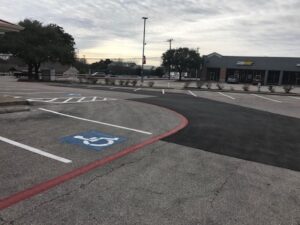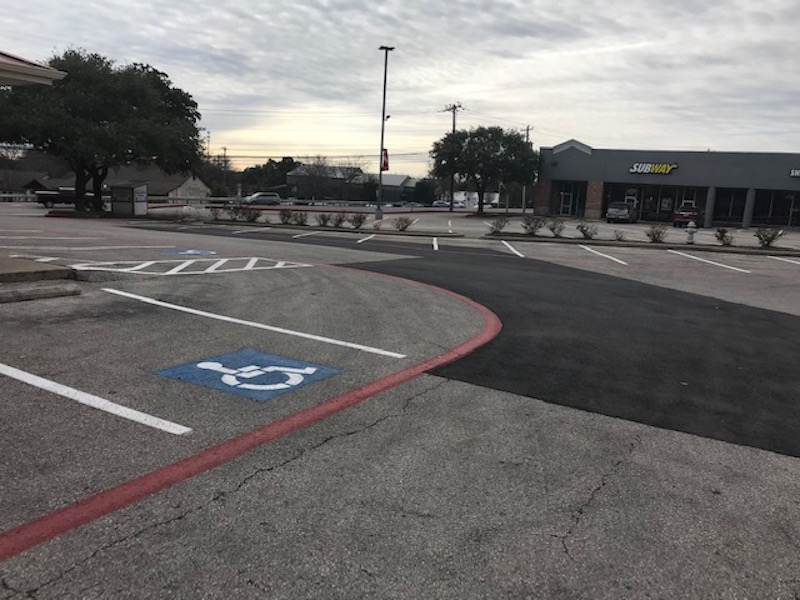 When many people visualize a parking lot, the first images that come to mind are the stripes that outline the parking spaces, the wheel stops within the spaces, and a pavement stencil to denote a handicapped parking space. Upon further reflection, they may identify a crosswalk, a speed bump, or a directional arrow. Relatively few will remember seeing a fire hydrant, the access aisle beside a handicapped parking space, or a marked fire lane. However, as the property owner or manager, you are responsible for all features that contribute to the city, state, and federal laws to ensure you are ADA compliant. Therefore, when you begin searching for a contractor to provide your parking lot striping service, you should make sure that you choose someone extremely knowledgeable about all relevant laws in your location. Otherwise, you could find yourself paying fines or defending against a lawsuit.
When many people visualize a parking lot, the first images that come to mind are the stripes that outline the parking spaces, the wheel stops within the spaces, and a pavement stencil to denote a handicapped parking space. Upon further reflection, they may identify a crosswalk, a speed bump, or a directional arrow. Relatively few will remember seeing a fire hydrant, the access aisle beside a handicapped parking space, or a marked fire lane. However, as the property owner or manager, you are responsible for all features that contribute to the city, state, and federal laws to ensure you are ADA compliant. Therefore, when you begin searching for a contractor to provide your parking lot striping service, you should make sure that you choose someone extremely knowledgeable about all relevant laws in your location. Otherwise, you could find yourself paying fines or defending against a lawsuit.
How to Keep Your Parking Lot ADA Compliant With Fire Lane Striping
What Are the Requirements for Fire Lanes in Parking Lots?
Fire lanes pose an interesting problem. Depending on your location, the fire marshal, fire chief, or municipal government may specify the size and location of mandatory pavement striping, the spacing between signs, or other details. However, in most towns, the entire fire lane features red curbs with white block letters identifying the area as a fire lane. The pavement striping usually is red, but the spacing between the stripes can vary by location. Depending on the spot, permanent signs must be spaced between 50 and 100 feet apart. Most municipal codes also require specific text and colors for the signs.
What Is the Purpose of Marking Fire Lanes in Parking Lots?
Firefighters, paramedics, and law enforcement officers need an unobstructed path to respond to emergencies. By their very nature, fire lanes are no-parking zones so that the area remains clear for emergency response vehicles. People are allowed to drive in a fire lane, but they cannot park, and, in some locations, they cannot stop in a fire lane to drop off or pick up a passenger.
How Do Striping Contractors Help Ensure That a Parking Lot Complies With the ADA?
Professional striping contractors evaluate parking lots by using up-to-date compliance regulations. Regulations change periodically, so a parking lot design that was fully ADA compliant in 2008 may be woefully out of compliance today. You must correct any compliance issues when you have a contractor repaint your parking lot striping, so this is an ideal time to seek a professional opinion on your layout. An experienced contractor will determine the number of car-accessible handicapped spaces you need, the number of van-accessible spaces you need, and the appropriate locations for them. Most businesses need one accessible space for every 25 regular spaces, but there are exceptions. For example, physical therapy facilities must make 20% of their visitor and patient spaces accessible. Your contractor’s evaluation will also consider the slope of the pavement in the parking spaces and access route, whether there are any obstacles you need to address and the signage that you must provide.
To Ensure Compliance, Contact Alpha Paving
At Alpha, we are extremely knowledgeable about the ADA and the compliance standards established by individual cities and counties. We provide a full range of paving services, including parking lot striping, asphalt paving, parking lot signs, thermoplastic striping, sealcoating, road striping, asphalt milling, concrete repairs, street maintenance, concrete flatwork, asphalt crack and pothole repairs, road construction, and asphalt resurfacing. We have an unparalleled reputation for superior customer service, remarkable craftsmanship, and dependability. If you would like us to work up a free quote for you, you can submit our online form or call our headquarters in Round Rock at 512-677-9001.




